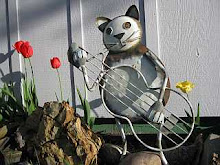As you can see in some of the photos, the old gate was two chain link fence gates I used for the past decade. They worked well until this year when Maria (cow #7) pushed against them. She had popped off, on one side of one gate, the clips holding the links in place. She was trying to squeeze through the gate when I caught her.
Hmmm... time to upgrade this gate sooner than later.
I installed a regular HW livestock gate. As you can see I added boards on each side of the gate. This is because I decided to "cut the corner off". The "corner" wasn't used - or needed - for the fruit tree and garden area. Also, having the gate at this angle is more convenient for entering this area. And, the old fence for the corner was wimpy.
 |
| Nice having a tractor to hold the gate as I decided where to drill through the posts for the bolts. |
 |
| A much nicer gate, and better and cleaner looking fence. |
Instead of using my normal railroad tie to hold the gate I used some large fence posts. Using a rounded fence post allows me to open the gate more than a 180 degree radius. That should come in handy when carrying the long irrigation pipes in and out of this area.
I used some of my 8 ft tall fence posts. The light - blonde - fence posts were not treated. My neighbor Curtis thought he had some preservative, but when he looked, he didn't. So, I used some used motor oil. I put the posts in a bucket and poured the oil on the posts a number of times to get the oil to soak into the wood. After several days of soaking, and shortly before I put the posts into the ground, I "painted' the soaked area with roofing sealant, making sure not to "paint" the bottom end of the post (no sense sealing in any moisture that may migrate down inside the post from above the treated area).
I wrapped the sticky sealed part of the post to make handling the post easier as the sealant was still sticky. And the plastic is yet another barrier to water and rot.
My main concern was to treat the posts at ground level and four or so inches lower as this is where posts normally rot first. For whatever reason I miscalculated and the top of my sealed and wrapped area was a few inches below ground. So I had to add more oil and sealant and plastic.
I hope my treatment of the posts allow them to remain rot-free for many years.
I have lots of roofing sealant left over from my previous roofing project. I had the can sitting in this location so the sealant would warm up in the sun one morning. My neighbor Jan came over later looking for me while I was gone. She ended up turning around in my yard near here. She had her two dogs in her SUV with her. The calves were still in the corral. I imagine it was a 3-ring circus and that is why Jan didn't see the can. She ran over it denting the can. Fortunately, only a small amount of sealant leaked out onto the grass from the lid.
As you can see in the following photo I did a little more than replace the gate. I added a 15 feet section at the corner. The whole fence over to the yard fence on the right side of the photo was bad. When I took down the corner fence and gates I also took down the entire fence over to the yard fence. The old fence was so bad I had to use the corral panels to supplement the fence so I wouldn't worry about the cattle getting through the fence. With the corral panels in place, why did I need the old bad barb wire fence to catch and tear on my clothes?
I don't have the fence rebuilt all the way to the yard fence. That will wait till later. It took longer to assemble the materials for the fence than I expected. Both the boards and the posts were at the very bottom of their respective piles for posts and boards and took an afternoon to get.
Four of the posts needed to be treated, which took time.
And lastly, I need to fix the loafing shed roof which blew off in the windstorm last week. The 30 feet left of fence to be rebuilt will have to wait until another day (or year).













No comments:
Post a Comment